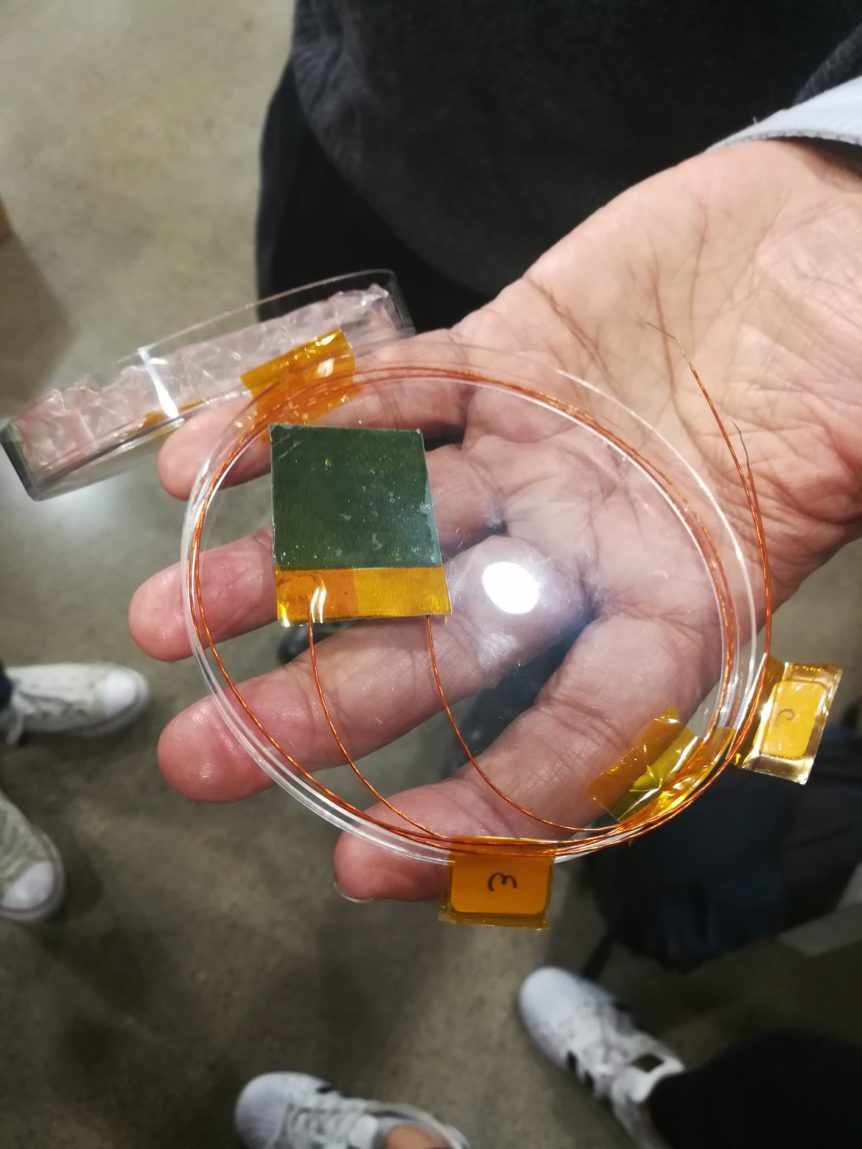Howdy!
See that above? It’s called a variable emmissive device (VED for short). Used in satellites and CubeSats, this little thing costs hundreds and hundreds of dollars. Here’s where we come in. Our team is seeking to develop a cost effective VEDs at 1/10th the price. As you may know, it’s been a wild and fast few weeks. Let’s tell y’all what we did!
The main setup for this quarter involves making an electrochromic thin film the size of a 2×2 inch square. Our team is divided up into three subteams. Two of these teams, the NiO (Nickel Oxide) and the WO (Tungsten Oxide) teams, The third team, the testing team, is making sure these devices work by noting a color change.
The Nickel Oxide team has been working hard to consistently meet weekly goals and has striven to improve their progress after each test run. Their success relies on the results from the team last year, as they strive to reproduce the color change with their films consistently. The team began testing around week 4 and have created a total of five films up until today. Though 4 out of 5 slides have been observed to form a color change (this is good!), substrate surface cleanliness was an issue the team needed to solve. A standard cleaning procedure, RCA-1, was proposed and implemented to resolve this issue. In the week before finals week, the team will be testing glass microscope slides in the deposition process with a solution of half the concentration, while testing the differences in film deposition at varying time intervals. With this experiment they expect to gain further understanding of the chemical interactions involved in the deposition process, film thickness relation with time and mixing rates.
Unlike the Nickel Oxide team, the Tungsten Team is new to this project. Previously, the electrochromic thin film that co-existed with the Nickel Oxide electrochromic thin films were Niobium based. Tungsten became of interest to the project and we have adopted it as the new source of thin films. The Tungsten Oxide team spent the early part of the quarter gathering supplies necessary for fabricating thin films and testing procedure/apparatus. By the middle of the quarter (Week 5), the subteam had two relatively nice slides ready for testing but there was some confusion as to how the slides would be annealed. A new method was developed for annealing in the following weeks, but the annealing temperature and time still needed to be addressed. As of now, the team’s plan is to run two different slides from past and current methods to attain a better understanding the differences between the methods.
The testing team may not seem much from the outside, but it is an essential part to this project. Their job is to test conductivity and quality films fabricated by teams mentioned above. The testing team had trouble too from the stuff left from last year. Many parts required for quality testing were missing or needed replacement. This quarter, the test chamber used for testing last year was refurbished to test film under simulated space conditions. A potentiostat was also made to control three electrode cells for electroanalytical experiments this quarter. By next quarter, the team will test emissivity of films in chamber with various high temperatures controlled by a hot plate and transmitted data through a cold plate, and hope to gain results.
In terms of our funding, our purchasing manager based our budget on purchasing habits made within the first half of the quarter and represent all expenses for the entire academic year. Chemicals for both the Nickel Oxide and the Tungsten Oxide teams are the most expensive portion of the budget, followed by testing equipment expenses, and miscellaneous. Our project is currently using MAE 189 funding, and we have applied for a UROP grant of $600 to help for the next two academic quarters. For more good news, collaboration between the project team and Northrop Grumman Corporation are currently underway to allow another avenue of funding and professional help with the project. We will hope to report more this quarter.
Finally, in terms of safety precautions, our safety officer has made sure to track down and increase awareness of potential lab and manufacturing hazards. The team has worked on documentation of SDS documents, completing online training modules, and submitting safety observation reports. For us to be more proactive next quarter, we will be implementing biweekly safety observation reports for the team to complete. This will serve as a resource for reference for future testing and development.
Anyways, things are looking up for all our teams. Hopefully we have caught up with what we have done the past few weeks. We’ve apologized for this inconsistency. Hope to see you all again before finals week! Trust me, the next post will be way, way shorter.
See y’all soon!
The Spacecraft Thermal Management Team
Composed Together By:
William Jo – Documentation Manager

